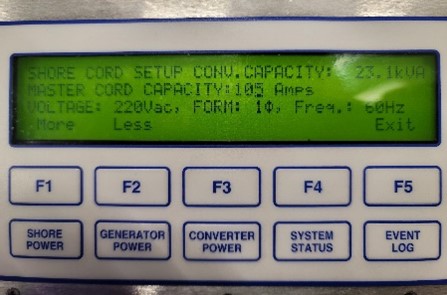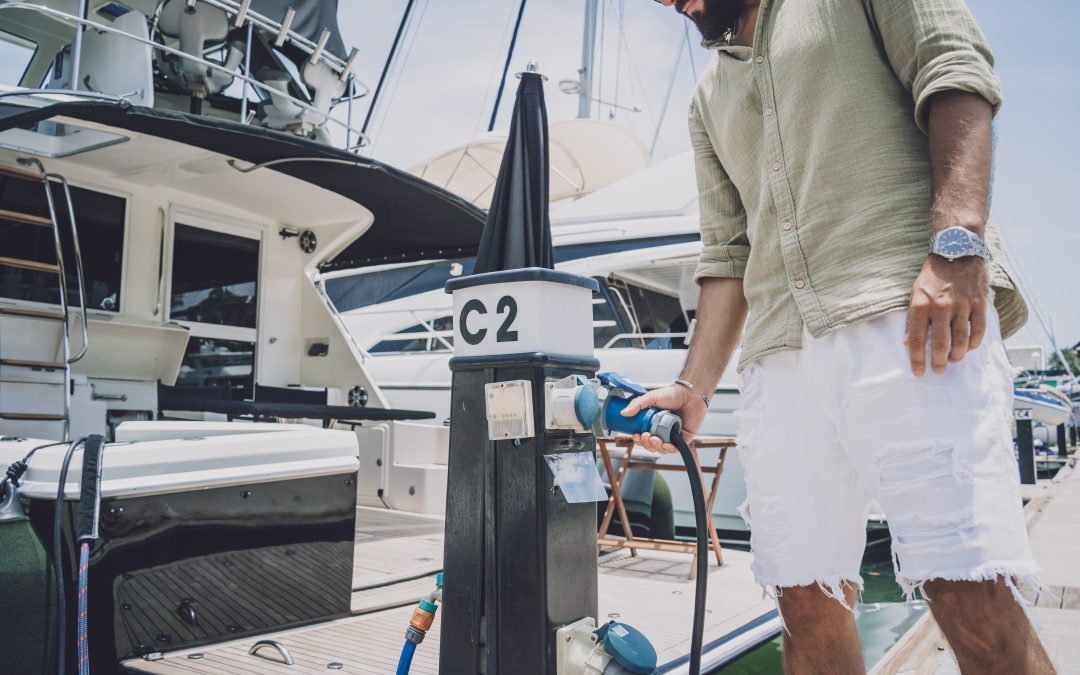Having an ASEA shore power converter gives yachts the flexibility to connect at a variety of marinas and ports worldwide while safeguarding their electrical systems. This flexibility, however, can sometimes lead to confusion about how much power can be safely drawn from a given dock. To ensure safe operation, it’s essential to consider four key components: the dock pedestal, the ship’s shore cord, the ship’s shore breaker, and the ASEA shore power converter.
The two most critical factors in managing power compatibility are current and voltage ratings. Mismanagement of these elements can result in overheating of the shore cord, potentially leading to system damage or even fires. Here, we discuss scenarios where shore cord limitations and electrical infrastructure require careful planning to ensure safe and efficient power delivery.
SCENARIO 1: SHORE CORD LIMITATIONS
A yacht equipped with a 100kVA ASEA shore power converter is connected to a dock pedestal using a shore cord rated for 100A. The power compatibility varies significantly depending on the dock voltage:
At 240V Single-Phase Dock:
Using the formula:
Power (kW)=Voltage (V)×Current (A)×Power Factor (pf)
Assuming a power factor of 1:
Power (kW)=240V×100A=24kW
The available power is 24kW, far below the converter’s 50kVA capacity, limiting the yacht’s operational loads.
At 400V Three-Phase Dock:
Using the three-phase power formula:
Power (kW)= √3×Voltage (V)×Current (A)×Power Factor (pf)
Assuming a power factor of 1:
Power (kW)=1.732×400V×100A=69.3kW
The higher voltage allows the same 100A shore cord to deliver nearly three times the power, enabling the yacht to operate all onboard systems.
At lower voltages like 240V, the yacht must draw higher current to maintain the same power output, potentially overloading the 100A-rated shore cord and dock pedestal. This can lead to overheating of the shore cord, increasing fire risks, or tripping breakers at the dock or onboard.
Solution:
ASEA’s Shore Cord Alarm can be configured to limit the current draw to match the shore cord’s capacity, protecting the dockside and onboard systems. However, this restricts available power, necessitating the prioritization of essential loads at the yacht’s distribution panel.



Alternatively, upgrading the shore cord and upstream wiring to handle higher current may be required, though it involves significant cost and logistical challenges, especially when switching back to higher voltage docks in Europe. For detailed calculations, download the file for quick reference to voltage, current, and power requirements.
SCENARIO 2: Converter Capacity Limitations
In cases where the shore cord is adequately sized, but the converter cannot handle the required power, the available power is dictated by the converter’s kVA rating. For example:
A dock supplies 400V three-phase power at 125A, providing:
Power (kW)=1.732×400V×125A=86.6kW
If the yacht’s ASEA shore power converter is rated at 50kVA, only 50kW (considering power factor as 1) of power can be delivered to downstream loads, regardless of the dock’s capacity.
Solution
Operators must decide between:
- Upgrading to a higher-capacity converter to fully utilize the dock’s power. (Refer to Voltage Input/Output Reference Tables)
- Prioritizing essential loads by selectively shutting off non-critical systems at the distribution panel.
Upgrading the converter provides long-term flexibility but involves upfront costs and installation downtime. Selecting essential loads ensures immediate functionality without additional investment.
SCENARIO 3: Insufficient Shore Cord and Converter Capacity
If both the shore cord and the converter are undersized, neither can meet the yacht’s power demands. For example:
A yacht docked at a 240V single-phase marina with a 50A shore cord has a maximum power supply of:
Power (kW)=240V×50A=12kW
Even if the dock pedestal could supply more current, the 50A shore cord and a 50kVA converter limit the available power.
Solution
- Replace the shore cord and breakers to handle higher currents, ensuring compatibility with the dock’s capacity.
- Upgrade the converter to meet the yacht’s load demands.
This dual upgrade offers the most comprehensive solution but comes with significant costs and logistical challenges. Additionally, the wiring and breaker upgrades may not be compatible when returning to higher voltage docks in Europe, requiring further modifications. (Voltage Input/Output Reference Tables for sizing and selection)
Key Considerations for Service Partners
- Dock and Shore Cord Compatibility: Ensure that the shore cord and dock pedestal can handle the required current without overheating or tripping breakers.
- Prioritizing Essential Loads: Configure the ASEA shore power converter and distribution panel to manage reduced power availability at lower voltage docks.
- Upgrading Infrastructure: Understand the cost and operational implications of upgrading shore cords, breakers, and converters to meet higher power demands.
- Flexibility vs. Investment: Work closely with operators to balance the need for operational flexibility with the cost and feasibility of system upgrades.
By addressing these scenarios, ASEA service partners can help operators ensure safe, reliable, and efficient power delivery wherever their journeys take them. For detailed calculations, download the Power Rating Table for quick reference to voltage, current, and power requirements.

